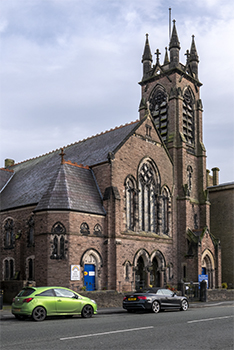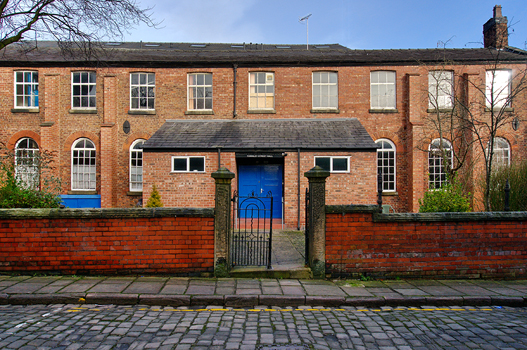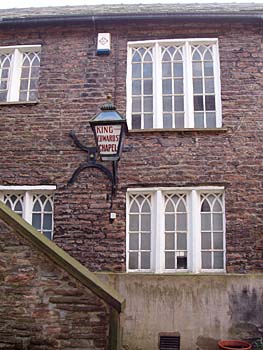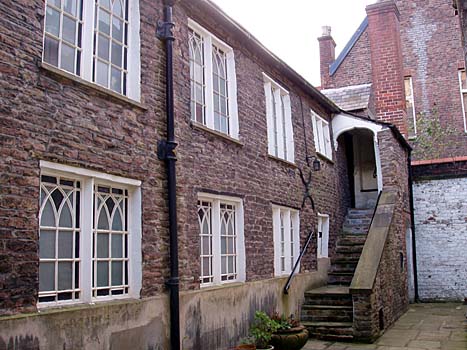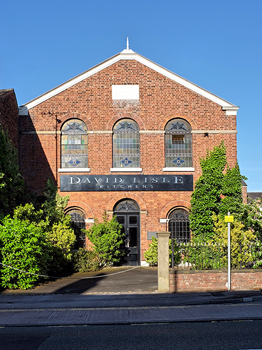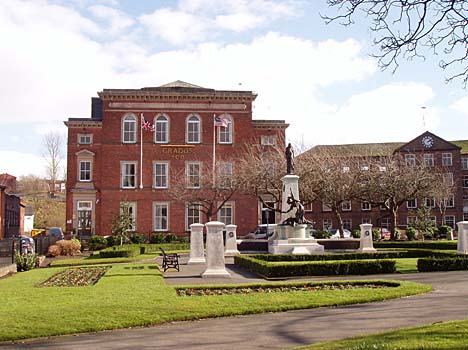MACCLESFIELD No. 8
Nonconformist Chapels
10 Feb, 3, 4 & 7 March & 23 May
2005, 23 & 24 Aug 2011, 25 March 2013, 25 Jan 2015, 26 Feb 2015, 3 June 2015 & 8 Nov 2019, 23 Nov 2020
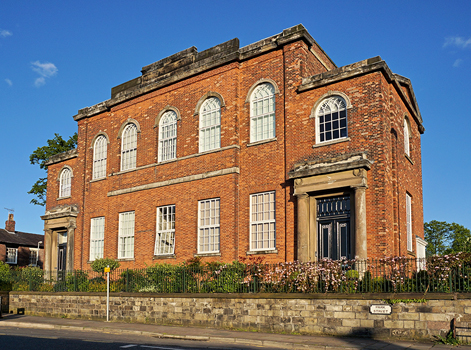 |
|
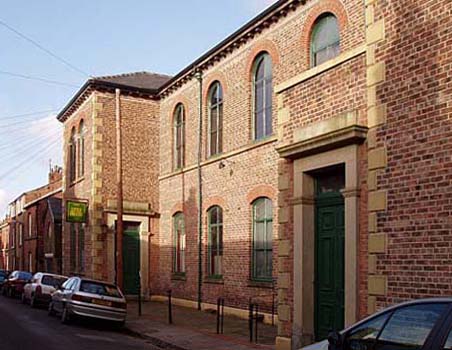 |
| Methodist New Connexion, Park Street, in 2015 |
|
Methodist New Connexion, Lord Street Sunday School |
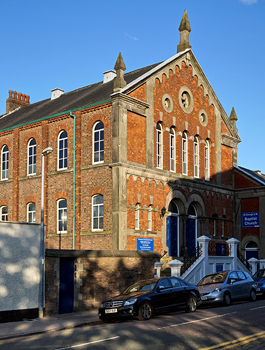 |
|
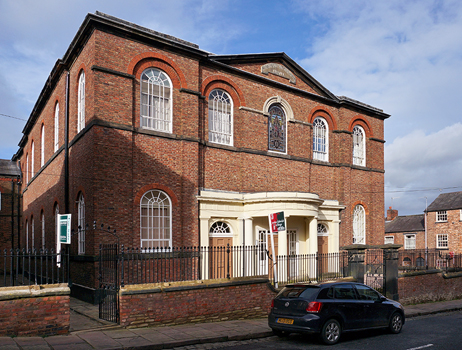 |
| Baptist Chapel, St. George's Street, 1873 |
|
Wesleyan Methodist Chapel in Feb 2015 |
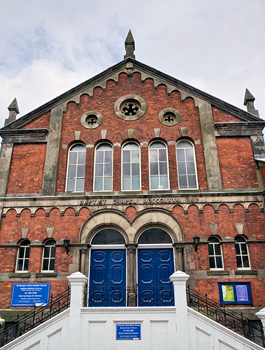 |
|
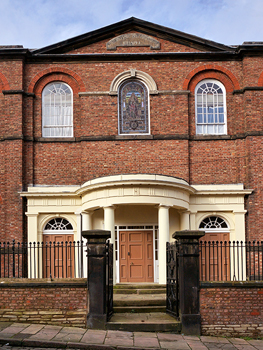 |
| Baptist Chapel in Feb 2015 |
|
Frontage of Wesleyan Chapel in Feb 2015 |
Macclesfield has a collection of substantial Nonconformist Chapels,
dating from 17th, 18th and 19th centuries. Starting at the top left, the following
chapels are shown:
The New Connexion Chapel was built in 1836, where Park Street becomes Park Road. The first service
was on 12 March 1837. The New Connexion Society was formed in 1797. It had
split from the Wesleyans over the role to be played by the laity. They wanted
more control by the congregation and less by the ministers. For many years in the late 20th Century the chapel was used by Harvest Printers but has since been converted to apartments. The view above was taken at about 7.30 pm on a midsummer evening. A Sunday School
was originally held in the vestry of Parsonage Chapel in 1820 by David Oldham,
a silk throwster. The school outgrew its accommodation and in 1822 a building
was acquired in Lord Street which was used for silk thowing during the week
and as a Sunday School. This building was demolished and replaced by the present
building in 1869. It has been converted in the late 20th century for use by
the Macclesfield Amateur Dramatic Society (MADS) and is now known as The Little
Theatre.
St. George's Street Baptist Chapel
was built in 1873-4. The baptists had formerly had a chapel in Calamine Street,
off Windmill Street. Sunlight reaches the frontage in the evening and one of the shots above was taken in June about 7.30 pm
The Brunswick
Methodist Church in Chapel Street, built in 1823-4 and enlarged
in 1850 has five bays, two tiers of arched windows, segmental porch on Tuscan
columns and a three bay pediment.
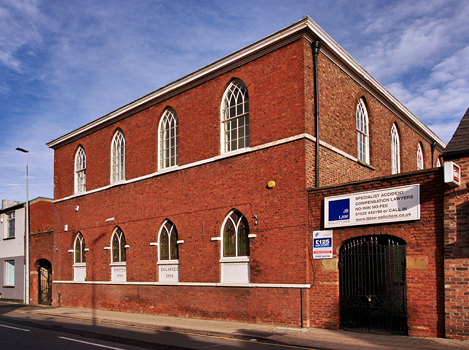 |
|
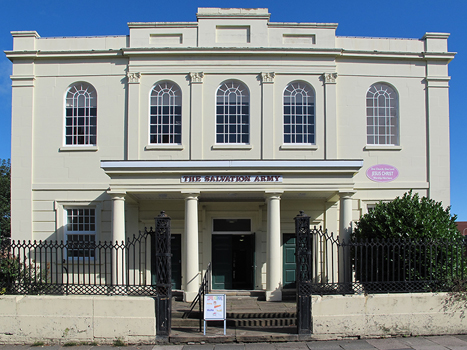 |
| Sunderland Street Chapel, built 1779, enlarged 1799 |
|
Roe Street, Kid's Chapel of 1829, now the Salvation Army |
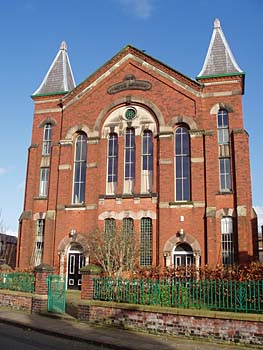 |
|
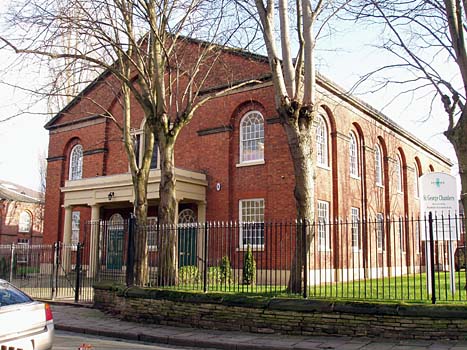 |
| Primitive Methodist Chapel, South Park Road, 1873 |
|
Built in 1822 as St. George's Independent Chapel |
Wesley's Chapel, is on Sunderland Street. This street was
a lane through fields alongside the River Bollin in the mid-18th century.
The area was known as the Heyes and the chapel built there in 1779 was known
as the chapel in the Heyes. John Wesley preached in Macclesfield in 1747 near
Waters Green, in front of the house owned by Mr. George Pearson, believed
to be where the Queen's Hotel now stands. George Pearson built Sunderland
Street Mills. The chapel was built on a piece of land given by Mr. John Ryle,
a banker. In 1798 there were three three Methodist ministers in the town,
all of whom went on to become Presidents of the Methodist Conference viz.
Edward Reece in 1816, George Marsden in 1821 and James Townley in 1829. The
chapel was the scene of a disaster in 1798 when a panic broke out following
a rumour that the roof was unsafe. People rushed for the door and six people
were killed in the crush with many others injured. A new chapel was built
on the site in 1799 and Mr. John Ryle donated £1,000 towards it. Note the large entrance to the right which was to allow horses to be taken to stabling at the back. The chapel is now a pool hall.
In early 2010 I was contacted by Ruth Bradley in Australia. She is looking into the life of the Reverend William Wilson. He was born in Scotland in 1828, went to Liverpool where he attended Wavertree Wesleyan Chapel. He entered Richmond Wesleyan Theological College in 1850 and became a Wesleyan Minister for foreign missionary service. He married in 1853 and he and his wife went to the Fiji Islands. At that time there was great trouble there with wars and cannibalism. They had three sons born in the Fiji Islands but when his wife died the Rev Wilson returned to England with his three infant sons. He served in various chapels including Sunderland Street and Brunswick Chapel in Macclesfield from 1888-1891.
Roe Street Chapel also known as Kidd's
Chapel, was
built in 1829 by a breakaway group from St. George's Independent Chapel for
Protestant Dissenters, which had been erected in 1822. This group of the congregation
wanted a Congregational or Independent Chapel while the others wished to become
part of the Established Church. As a result St. George's,
in High Street, see below, was consecrated
by the Bishop of Chester. Those Dissenters who had contributed to the original
building as shareholders got their money back! The break-away group worshipped
initially at Brunswick Methodist Church but then built Roe Street Chapel.
In 1926 the congregation united with that of Frost's Chapel at Park Green
to form Macclefield Congregational Church. The building was used for a time
as a parish hall by the Roman Catholic St. Alban's church. It was used as a dance hall in the middle of the 20th century. It is now the Salvation
Army Citadel; the former site of the citadel was in Mill Street just below the Majestic cinema.
St. George's in High Street was built as St. George's Independent Chapel for Protestant Dissenters in
1822-3. It is three bays by seven with two tiers of windows. The facade has
a porch of four Tuscan columns. with a Venetian window. It had three galleries
inside. St. George's was converted to offices known as St. George's Chambers
in 2004.
The United Reformed Church at Park Green has its origins in the late 18th century. A Calvinist Chapel
was built in Townley Street, just behind the present church in 1788.
It was built by a group that had split from the King Edward Street Chapel
when it switched from being Presbyterian to Unitarian (see below). Those who
left the chapel at this point met for a time in a barn in Mill Street, then
in an old factory. Eventually they erected the Townley Street Chapel which
was enlarged in the early 19th century. It was known as the Ebenezer or Townley
Street Chapel. There were at this time 600 members of the adjoining Sunday
School. The United Reformed Church is the sandstone building facing Park Green
and was built in 1877 at a cost of £10,000 by C. O. Ellison. Later the
Townley Street Chapel was turned into a day school. This area is hard to photograph
as it is surrounded by buildings, has cars in front and is commonly in shade but my picture shows how Townley
Street School would look, were it not for the lamp-post in front of it! In November 2019, during a coffee morning, I had the opportunity to take a photograph inside the church. The interior has been modified in recent years with the old pews replaced by modern seating and a glass and wood partition created at the back of the nave. The wood from the old pews was used in the partition This creates a space between the entrance and the partition that can be used for catering and a book stall. The huge dark pulpit has been removed from the nave and installed upstairs on the gallery. The shot below was taken in ambient light from the gallery.
| |
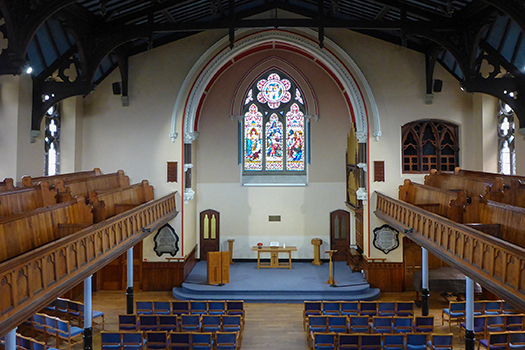 |
|
| |
The interior of the United Reformed Church |
|
The United Methodist Chapel on Park Green is also known as Frost's chapel as it was taken over by the owners of the adjacent mill. It is now part of Gradus. It was built in 1858 and closed in 1950. Records of baptisms 1856-1940 and marriages 1904-1939 are at the Cheshire Record Office.
King Edward Street Chapel is hidden from view and faces north to the backs of buildings whose frontage
in on the south side of King Edward Street. Access is gained through a narrow
passage between two buildings. The design is very similar to that of Brook
Street Chapel in Knutsford and Dean Row in Wilmslow. The chapel is the oldest
in the town; it was built in 1689 and opened on 24 August 1690. It arose from
the Act of Toleration of 1689 which ended some of the persecution of Dissenters
from the laws passed in the Cavalier Parliament after the Restoration of the
Monarchy. James II, a Catholic, had fled and his son-in-law, William of Orange
and his daughter, Mary, came to the throne in the so called Glorious Revolution.
The Act exempted Dissenters from attending services at Anglican Churches and
allowed them to build their own chapels. William Stonehewer and Humphry Higginbotham
were the two men behind the building. The chapel was Presbyterian until 1764
when the Rev. John Palmer, a Unitarian trained at Warrington Academy, was
appointed minister. Among those who signed his recommendation was Joseph Priestley,
the discoverer of oxygen, who was at that time a tutor at Warrington. The
chapel was supported by the Brocklehurst family in the 19th century but when
Charles Brocklehurst moved to London the chapel fell into disrepair and the
organ was damaged. It was restored in 1890 and in 1929 further alterations
were made with new pews and a wooden floor.
Beech Lane Primitive Methodist
Chapel has a plaque indicating construction in 1830. Next to it is a building
that was a Sunday School with the plaque indicating construction in 1835.
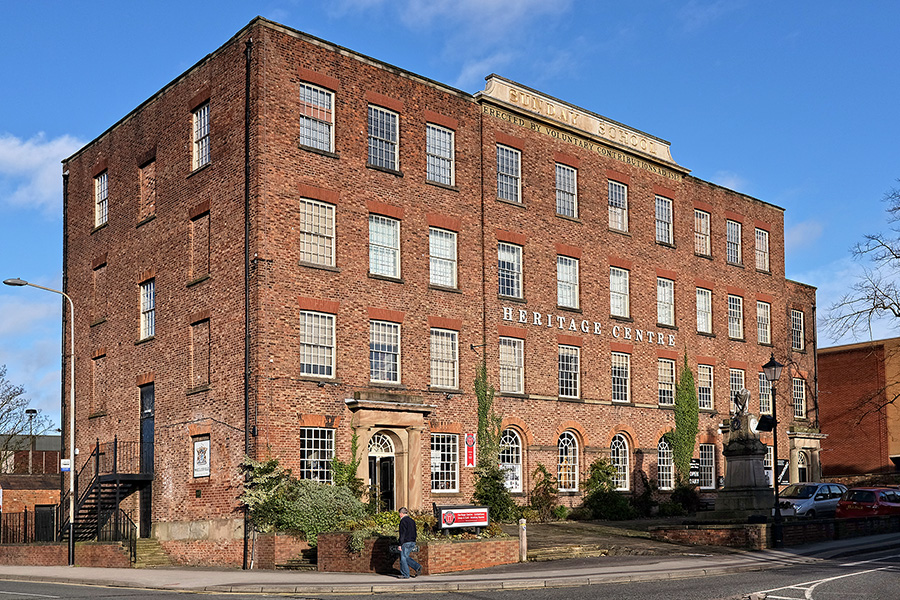 |
| Macclesfield Sunday School: The Heritage Centre (January 2015) |
The Macclesfield Sunday School is now the Silk Heritage Centre,
with a museum section, the large auditorium used for concerts and films, a shop and
and cafe. The school dates from 1814. The Rev. David
Simpson at Christ Church had introduced a charity school into the town
in 1788, giving lessons to children in the evening. At that time there were
no factory acts regulating children's working hours. John Whitaker (1772-1820)
started a Sunday School in 1796. He was a Methodist and at the time was only
24. However, he believed in the importance of education in giving people access
to the bible. He started with a single room in Pickford Street and then used
an old factory in Duke Street. In 1812, he was using five buildings for a total
of 2267 scholars. A new building was then required and the Roe Street site
selected. The building commenced on 21 April 1813 and was opened on 10 April
1814. The cost was £5,600 of which £1,500 was raised by the pupils.
Whitaker was the school superintendent until his death in 1820. It is perhaps
surprising to today's visitors that education at the school was not intended
to improve the social position of the working people; children had to accept
their place in society, be good citizens and respect their "betters".
The school was non-denominational and took pupils from the age of 6. It was
an independent school with no ties to either the Anglicans or Methodists.
As the school had the largest hall in the town, it was used for social activities
from the middle of the 19th century.
A three page pamphlet, from which this information is drawn,
is available from the Heritage Centre Shop.
Sources
The Buildings of England, Cheshire, by Nikolaus Pevsner
and Edward Hubbard, Yale University Press, 2003, First edition by Penguin
in 1971
Pamphlet available at King Edward Street Unitarian Chapel
108 Steps Around Macclesfield by Andrew Wild, Sigma Press, 1994, ISBN:
1-85058-436-2
Macclesfield
Page 1: Town Centre
Macclesfield Page 2:
Town Centre
Macclesfield Page 3:
Halls
Macclesfield Page 4: The
Canal
Macclesfield Page 5:
Christ Church
Macclesfield Page 6:
St. Michael's, the Exterior & Nave
Macclesfield Page 7:
St. Michael's the Savage Chapel
Macclesfield Page 8: Nonconformist Chapels
Macclesfield
Page 9: Some Macclesfield Mills










